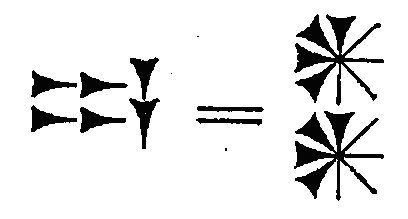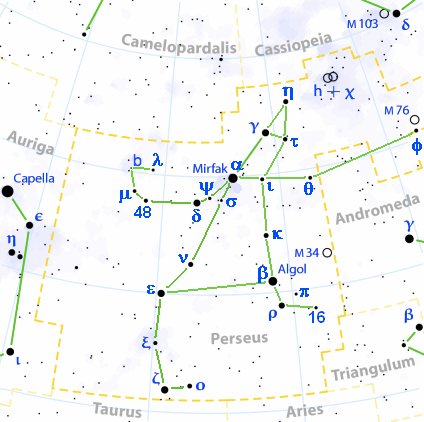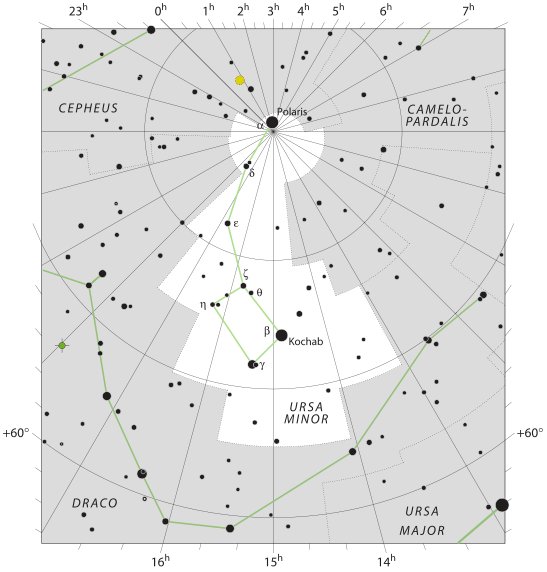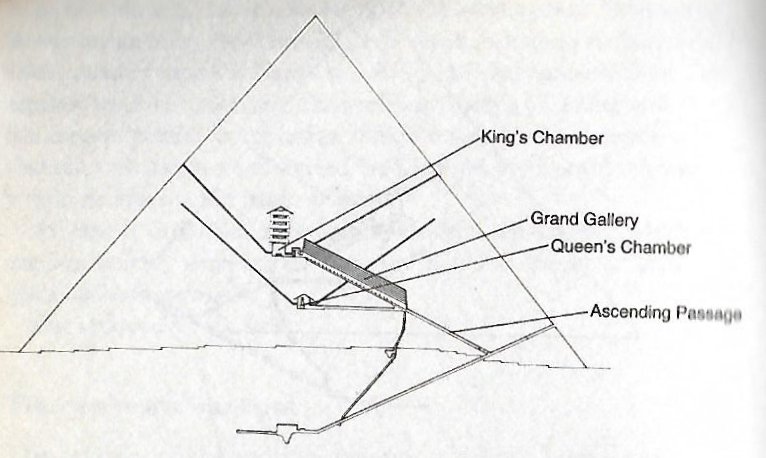TAHUA
2. We should remember that on one side of the year
was Bharani (→ May 1) and on the other side was Zuben Elgenubi
(→ October 31):
 |
|
 |
 |
|
Cb1-15 |
Cb1-16 (392 + 16
= 408) |
Cb1-17 |
|
Oct 31 (304) |
Nov 1 (*225) |
2 |
|
Al Zubānā-14a (Claws)
/
Visakha-16 (Forked)
/
Root-3 (Badger)
ZUBEN ELGENUBI (Southern Claw) =
α
Librae
(224.2),
ξ
Bootis,
ο
Lupi (224.5) |
KOCHAB (Kakkab, Babylonian for Star) = β Ursae Min.
(225.0),
ξ Librae (225.7)
 |
KE KWAN (Cavalry Officer) =
β
Lupi
(226.3),
KE KWAN =
κ
Centauri (226.4),
ZUBEN ELAKRIBI (Claw of the Scorpion) =
δ
Librae
(226.8),
π¹
Oct.
(226.9)
*185.0 = *226.4 - *41.4 = "Sept 22 (265) = equinox |
|
Bharani-2
(The Bearer)
/
Stomach-17
(Pheasant)
π Arietis (41.2),
MIRAM = η Persei
(41.3),
BHARANI = 41 Arietis (41.4),
τ² Eridani, σ Arietis (41.7) |
TA LING (Great Mound) = τ Persei (42.4)
*1.0 = *42.4 - *41.4 |
ρ
Arietis (43.0),
GORGONEA SECUNDA =
π
Persei
(43.5),
ACAMAR (End of the River) =
θ
Eridani
(43.6),
ε
Arietis (43.7),
λ
Ceti (43.9)
DENEBOLA (β Leonis) |
| e niu tu |
ki te ariki - e ka
hua ra tona rima |
koia kua iri i
ruga o te rima - e o to vaha mea |
|
Niu.
Palm tree, coconut tree; hua niu,
coconut. Vanaga. Coconut, palm, spinning top. P
Pau., Ta.: niu,
coconut. Mgv.: niu,
a top; niu mea,
coconut. Mq.: niu,
coconut, a top. Churchill. The fruit of
miro. Buck.
T. 1. Coconut palm. 2. Sign for peace. Henry
The sense of top lies in the fact that the bud end
of a coconut shell is used for spinning, both in the
sport of children and as a means of applying to
island life the practical side of the doctrine of
chances. Thus it may be that in New Zealand, in
latitudes higher than are grateful to the coconut,
the divination sense has persisted even to different
implements whereby the arbitrament of fate may be
declared. Churchill 2. |

| |
365 days |
| |
(80 + RA / 24h * 365¼) |
|
Day of culmination |
|
|
Atlas |
May 16 (136) |
*229 |
December 31 (365,
*285) |
135 |
|
Alkes |
September 3 (246) |
*229 |
April 20 (110) |
135 |
|
Denebola |
September 15 (258) |
*230 |
May 3 (123) |
134 |
|
Thuban |
October 19 (292,
*212) |
*230 |
June 7 (158, *78) |
134 |
|
Arcturus |
October 22 (295,
*215) |
*227 |
June 8 (159, *79) |
*136 |
|
Zuben
Elgenubi |
October 31
(304, *224) |
|
June 17 (168, *454.
*88) |
*136 |
 |
|
Vega |
December 27 (361,
*281) |
*227 |
August 12 (224, *144) |
*137 |
|
Alphekka Meridiana |
January 5 (*290) |
*220 |
August 13 (225, *145) |
'146 |
|
Deneb Cygni |
February 7 (38, *323) |
*221 |
September 16 (259,
*179) |
*144 |
|
Fomalhaut |
March 3 (62, *348) |
*236 |
October 25 (*584, *218) |
|
| |
|
Alrisha |
April 19 (109, *212 -
*183 = *29) |
*232 |
December 7 (341,
*261) |
132 |
| Menkar |
May
4 (124, *44) |
*231 |
December 21 (355,
*275) |
133 |
|
*364 - *229
→ 135 etc. And *144 (August 12) = *281 (December
27) - *137, etc. |
And according to my
preliminary results the corresponding place in the text on
the Tahua tablet should be:
 |
 |
 |
|
 |
 |
 |
|
Ab1-8 (1335 + 7) |
Ab1-9 |
Ab1-10 (90 + 580 + 10 = 1344) |
Ab1-11 |
Ab1-12 |
Ab1-13 (1347) |
|
29 (→ 152 + 150) |
Oct 30 |
Halloween |
Samhain (*225) |
2 (306 = 123 + 183) |
Nov 3 (*227) |
|
20 Aug (*152) |
21 Aug |
22 Aug |
23 Aug |
24 Aug (236) |
25 Aug (*157) |
| |
|
ZUBEN ELGENUBI |
 |
|
|
|
CLOSE TO
THE FULL
MOON: |
|
April 29 |
30 |
Beltaine (50 + 71) |
|
2 |
3 (123) |
4 |
|
19 Febr |
20 Febr (*336) |
21 Febr (29 + 21) |
22 Febr |
Terminalia |
|
|
|
|
BHARANI |
|
DENEBOLA |
MENKAR |
| Ko te
maitaki - ko te
maharoga |
hetuu e roia |
- |
e
ragi huhuki |
eaha ia |
ko te Rei oho ia mai |
|
Haro. To pull; popohaga o te rua raá, i
haro i te aka o te miro, on the morning of the second day, they
pulled up the anchor of the boat. He haro i te hagu a roto,
to draw in air, to breathe. He-haro te vaka i te au , the
boat is towed off course in the current. Vanaga. a. to point, to
raise the arm, to stretch out the hand or other member, to spread,
to point the yards. b. to hoist, to pull up, to entice. c. to
stiffen, to grasp, to squeeze. Haroharo, to point, to limp.
PS Sa.: falo, to stretch out. To.: falo, to stretch
out, to make tense. Fu.: falo, to stretch out, to lay hands
on. Churchill.
Hu. 1. Breaking of wind. T Mgv., uu,
to break wind. Mq., Ta.: hu, id. 2. Whistling of the wind, to
blow, tempest, high wind. P Pau.: huga, a hurricane.
Churchill. Mgv.: hu, to burst, to crackle, to snap. Ha.:
hu, a noise. Churchill.
|
It seems reasonable to assume that the importance of Bharani /
Zuben Elgenubi was due to Kochab at the time when this
star was regarded as the star at the norh pole.


From Kochab (*225 → 225 → August 13
→ Creation of Our Present World) to Polaris (the present north
pole star) the distance was 16 days (*26 + *16 = *225 - *183),
because Polaris was at the other side of the exact position of
the current north pole. →
168 + 16 = 184.
.jpg)
Ab1-11 (*225) - *16 = *183 → 1345 -
16 = 1329 = 664 + 665 (Aa8-80).
...
1329 (Aa8-80) → 1225 + 2 * 52
...
... When
it was
evident
that the
years
lay
ready to
burst
into
life,
everyone
took
hold of
them, so
that
once
more
would
start
forth -
once
again -
another
(period
of)
fifty-two
years.
Then
(the two
cycles)
might
proceed
to reach
one
hundred
and four
years.
It was
called
One
Age
when
twice
they had
made the
round,
when
twice
the
times of
binding
the
years
had come
together. Behold
what was
done
when the
years
were
bound -
when was
reached
the time
when
they
were to
draw the
new
fire,
when now
its
count
was
accomplished.
First
they put
out
fires
everywhere
in the
country
round.
And the
statues,
hewn in
either
wood or
stone,
kept in
each
man's
home and
regarded
as gods,
were all
cast
into the
water.
Also
(were)
these
(cast
away) -
the
pestles
and the
(three)
hearth
stones
(upon
which
the
cooking
pots
rested);
and
everywhere
there
was much
sweeping
- there
was
sweeping
very
clear.
Rubbish
was
thrown
out;
none lay
in any
of the
houses
...
 |
 |
 |
|
 |
 |
 |
|
Aa8-80 (1329) |
Aa8-81 (666) |
Aa8-82 |
Aa8-83 |
Aa8-84 |
Aa8-85 (1334) |
| ki to hatu huri |
ma to ua mata
- mae tae e ui hia
mai |
kua oho te tagata |
ki te henua |
- |
|
Oct 16 (260 + 29) |
17 (290) |
18 (472 - 181) |
19 |
20 |
21 (294) |
| |
|
|
THUBAN |
|
|
|
April 16 (314 *
1½) |
17 (16 * 29½) |
(365 + 108 = 473) |
19 |
ALKES |
21 (111) |
|
To.
1.
Particle
sometimes
used
with the
article
in
ancient
legends;
i uto
to te
hau,
the
ribbon
was in
the
float.
2. To
rise (of
the sun)
during
the
morning
hours up
to the
zenith:
he-to
te raá.
Vanaga.
1. Of. T
Pau.,
Ta.:
to,
of.
Mgv.:
to,
genitive
sign.
Mq.:
to,
of, for.
2. This,
which.
Churchill.
Mgv.:
To,
to make
a canoe
of
planks.
Mq.:
to,
to build
a canoe.
Sa.:
to,
to
build.
Churchill.
Huri. 1. To turn
(vt.), to overthrow, to knock down:
huri moai, the overthrowing of the statues from
their ahus during the period of decadence on
the island. 2. To pour a liquid from a
container: ka huri mai te vai, pour me some
water. 3. To end a lament, a mourning: he
huri i te tagi, ina ekó tagi hakaou, with this
the mourning (for the deceased) is over, there shall
be no more crying. 4. New shoot of banana:
huri maîka. Vanaga. 1. Stem. P Mgv.: huri,
a banana shoot. Mq.: hui, shoot, scion. 2. To
turn over, to be turned over onto another side, to
bend, to lean, to warp; huri ke, to change,
to decant; tae huri ke, invariable; huri
ke tahaga no mai, to change as the wind; tae
huri, immovable; e ko huri ke,
infallible; huhuri, rolling; hakahuri,
to turn over; hakahuri ke, to divine. P Pau.:
huri, to turn. Mgv.: huri, uri,
to turn on one side, to roll, to turn upside down,
to reverse. Mq.: hui, to turn, to reverse. 3.
To throw, to shoot. 4. To water, to wet. 5. To
hollow out. Hurihuri: 1. Wrath, anger;
kokoma hurihuri, animosity, spite, wrath, fury,
hate, enmity, irritable, quick tempered, to feel
offended, to resent, to pester; kokoma hurihuri
ke, to be in a rage. 2. (huri 4)
hurihuri titi, to fill up. 3. To polish. 4. (uriuri).
Hurikea, to transfigure, to transform.
Churchill. Mq. huri, resemblance. Sa.:
foliga, to resemble. Churchill. |
... The star [Thuban] could be seen, both by
day and night, from the
bottom of the central passage of the Great Pyramid of Cheops
(Knum Khufu) at Ghizeh, in 30° of north latitude, as also
from the similar points in five other like structures; and the
same fact is asserted by Sir John Herschel as to the two
pyramids at Abousseir ...
... For some reason, too, it had taken their
fancy to place the Great Pyramid almost exactly on the 30th
parallel at latitude 29º 58' 51". This, a former astronomer
royal of Scotland once observed, was 'a sensible defalcation
from 30º', but not necessarily in error: For if the original
designer had wished that men should see with their body, rather
than their mental eyes, the pole of the sky from the foot of the
Great Pyramid, at an altitude before them of 30º, he would have
had to take account of the refraction of the atmosphere, and
that would have necessitated the building standing not at 30º
but at 29º 58' 22' ...

|










.jpg)

